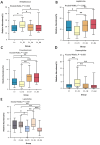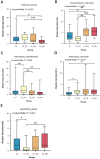A comparative study of microbial changes in dental plaque before and after single- and multiappointment treatments in patients with severe early childhood caries
- PMID: 38879477
- PMCID: PMC11179330
- DOI: 10.1186/s12903-024-04458-5
A comparative study of microbial changes in dental plaque before and after single- and multiappointment treatments in patients with severe early childhood caries
Abstract
Background: The status of dental caries is closely related to changes in the oral microbiome. In this study, we compared the diversity and structure of the dental plaque microbiome in children with severe early childhood caries (S-ECC) before and after general anaesthesia and outpatient treatment.
Methods: Forty children aged 3 to 5 years with S-ECC who had completed whole-mouth dental treatment under general anaesthesia (C1) or in outpatient settings (C2) were selected, 20 in each group. The basic information and oral health status of the children were recorded, and the microbial community structure and diversity of dental plaque before treatment (C1, C2), the day after treatment(C2_0D), 7 days after treatment (C1_7D, C2_7D), 1 month after treatment (C1_1M, C2_1M), and 3 months after treatment (C1_3M, C2_3M) were analysed via 16 S rRNA high-throughput sequencing technology.
Results: (1) The alpha diversity test showed that the flora richness in the multiappointment group was significantly greater at posttreatment than at pretreatment (P < 0.05), and the remaining alpha diversity index did not significantly differ between the 2 groups (P > 0.05). The beta diversity analysis revealed that the flora structures of the C1_7D group and the C2_3M group were significantly different from those of the other time points within the respective groups (P < 0.05). (2) The core flora existed in both the pre- and posttreatment groups, and the proportion of their flora abundance could be altered depending on the caries status of the children in both groups. Leptotrichia abundance was significantly (P < 0.05) lower at 7 days posttreatment in both the single- and multiappointment groups. Corynebacterium and Corynebacterium_matruchotii were significantly more abundant in the C1_1M and C1_3M groups than in the C1 and C1_7D groups (P < 0.05). Streptococcus, Haemophilus and Haemophilus_parainfluenzae were significantly more abundant in the C1_7D group than in the other groups (P < 0.05).
Conclusion: A single session of treatment under general anaesthesia can cause dramatic changes in the microbial community structure and composition within 7 days after treatment, whereas treatment over multiple appointments may cause slow changes in oral flora diversity.
Keywords: 16S amplicon sequencing; Dental treatment under general anaesthesia; Multiappointment treatment; Oral core flora; Severe early childhood caries.
© 2024. The Author(s).
Conflict of interest statement
The authors declare that they have no competing interests.
Figures





Similar articles
-
The short-term impact of comprehensive caries treatment on the supragingival microbiome of severe early childhood caries.Int J Paediatr Dent. 2024 Sep;34(5):505-515. doi: 10.1111/ipd.13151. Epub 2024 Jan 3. Int J Paediatr Dent. 2024. PMID: 38173170
-
[The effect of iron deficiency anemia and black stain on the microbial community of dental plaque in young children with early childhood caries].Zhonghua Yu Fang Yi Xue Za Zhi. 2024 Dec 6;58(12):1976-1986. doi: 10.3760/cma.j.cn112150-20240628-00522. Zhonghua Yu Fang Yi Xue Za Zhi. 2024. PMID: 39710477 Chinese.
-
Microbial shifts in dental plaque of children with severe early childhood caries following comprehensive dental treatment under general anesthesia.Front Cell Infect Microbiol. 2025 May 2;15:1541785. doi: 10.3389/fcimb.2025.1541785. eCollection 2025. Front Cell Infect Microbiol. 2025. PMID: 40384978 Free PMC article.
-
Dental plaque microbiota profiles of children with caries-free and caries-active dentition.J Dent. 2021 Jan;104:103539. doi: 10.1016/j.jdent.2020.103539. Epub 2020 Nov 25. J Dent. 2021. PMID: 33248211
-
Cariogenic microbiome and microbiota of the early primary dentition: A contemporary overview.Oral Dis. 2019 May;25(4):982-995. doi: 10.1111/odi.12932. Epub 2018 Sep 19. Oral Dis. 2019. PMID: 29969843 Review.
Cited by
-
Anesthetics change the oral microbial composition of children and increase the abundance of the genus Haemophilus.Transl Pediatr. 2024 Dec 31;13(12):2097-2109. doi: 10.21037/tp-24-336. Epub 2024 Dec 26. Transl Pediatr. 2024. PMID: 39823002 Free PMC article.
References
-
- Thang Le VN, Kim JG, Yang YM, Lee DW. Risk factors for early childhood caries: an Umbrella Review. Pediatr Dent. 2021;43(3):176–94. - PubMed
Publication types
MeSH terms
Substances
Grants and funding
- No. XTYB201830/Special Fund of the Pediatric Medical Coordinated Development Center of the Beijing Hospitals Authority
- No. XTYB201830/Special Fund of the Pediatric Medical Coordinated Development Center of the Beijing Hospitals Authority
- No. XTYB201830/Special Fund of the Pediatric Medical Coordinated Development Center of the Beijing Hospitals Authority
- No. XTYB201830/Special Fund of the Pediatric Medical Coordinated Development Center of the Beijing Hospitals Authority
- No. XTYB201830/Special Fund of the Pediatric Medical Coordinated Development Center of the Beijing Hospitals Authority
- No. XTYB201830/Special Fund of the Pediatric Medical Coordinated Development Center of the Beijing Hospitals Authority
- No. XTYB201830/Special Fund of the Pediatric Medical Coordinated Development Center of the Beijing Hospitals Authority
- No. XTYB201830/Special Fund of the Pediatric Medical Coordinated Development Center of the Beijing Hospitals Authority
- No. XTYB201830/Special Fund of the Pediatric Medical Coordinated Development Center of the Beijing Hospitals Authority
- No. XTYB201830/Special Fund of the Pediatric Medical Coordinated Development Center of the Beijing Hospitals Authority
- No. XTYB201830/Special Fund of the Pediatric Medical Coordinated Development Center of the Beijing Hospitals Authority
LinkOut - more resources
Full Text Sources
Medical
Miscellaneous

